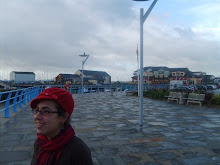 Roma is old, everywhere you look. Old, old, old. And everybody knows that old--whether the Sistene Chapel or vintage cowboy boots--is expensive. It costs twelve euro to see the 'inside' of the ruins of the Coliseum (includes Palatino and Foro Romano). No doubt it also costs a lot to keep these structures from crumbling completely--but that's the point. There is an obsession with keeping the old old, yet intact. And though it is not required, what often follows this is a love of money. Roma is host to a lot of great art, and some impressive buildings, but Roma's value lies, to some extent, no longer lies in its art, but in the pockets of its many tourists. The art itself is devalued by the masses that come to visit it and take it home with them, via a cell phone picture.
Roma is old, everywhere you look. Old, old, old. And everybody knows that old--whether the Sistene Chapel or vintage cowboy boots--is expensive. It costs twelve euro to see the 'inside' of the ruins of the Coliseum (includes Palatino and Foro Romano). No doubt it also costs a lot to keep these structures from crumbling completely--but that's the point. There is an obsession with keeping the old old, yet intact. And though it is not required, what often follows this is a love of money. Roma is host to a lot of great art, and some impressive buildings, but Roma's value lies, to some extent, no longer lies in its art, but in the pockets of its many tourists. The art itself is devalued by the masses that come to visit it and take it home with them, via a cell phone picture.Meanwhile, in Napoli, the old is of a particular sort that cannot be priced. It is the old of wrinkled women, fixing their socks in the street. They are crumbling like churches, but not yet dead. It is the old of the traditional bread, which one can imagine has tasted the same for generations (and for good reason). And Napoli is old in the way one does the shopping: still in specialized shops and streets--a street for bread and cheese, vegetables and fish, a street for wedding dresses, a street for corsets, one for musical instruments, and one for books. In some cases, the old is suffocated by the new. I saw a church surrounded on all sides by skyscrapers, its dome barely sticking out the top. The old exists, only not at the expense of the new. And both live together, one growing over and through the other like vines through the ruins.
In Napoli, oldness, and in particular the antiquity of death, cannot be avoided. With the gaping mouth of Mt. Vesuvius in plain sight (and, so scientists say, 150 years overdue for another deathly eruption), mortality is only a breath away. The city has a largesse, both sprawling and stacked, full of pickpockets and bullying nonas, full of squalor and inexpensive fruit, reckless waste and frugal spenders, with stunning parks and roofgardens, and streets of trash. In all of this, Neapolitans live close to and with a consciousness of the fragility of life, the incredible vulnerability and fallability of humans, (which is also what makes us such good artists). And so it seems that Neapolitans laugh louder and cry harder and live with more ferocity. And it is also out of this that life in Napoli is fluid. A street empties to make way for a scooter, only to flood with people in its wake. Everything is crazy. Everything is normal.
Neapolitans look at one another with curiosity, with intensity, and unabashedly. It's an imaginative land where everyone is wondering about the lives we lead. Everyone here is a writer in theory, in philosophy, in thought.
Above: The washing hanging out.


Your typical Italian flea market. Your typical Italian penis-fish joke.

Ragazze francesi e pizza margherita

Piazza del Plebescito, Napoli

The Bay of Naples. Mt. Vesuvio. A small gang of street dogs.



No comments:
Post a Comment